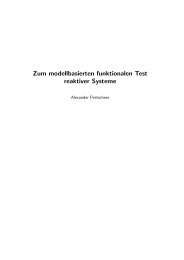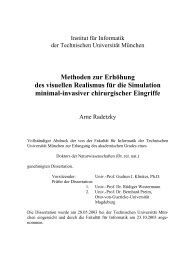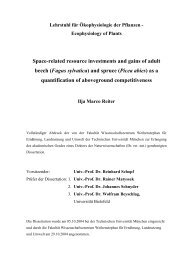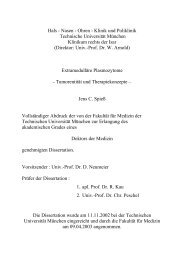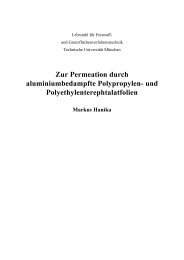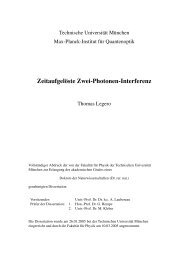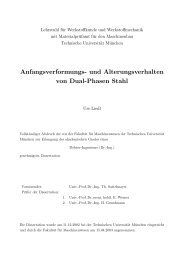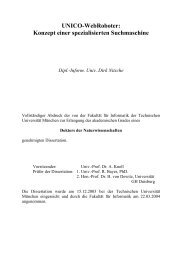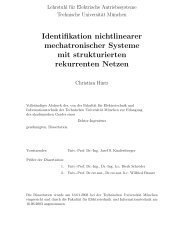Topologically Defined Neuronal Networks Controlled by Silicon Chips
Topologically Defined Neuronal Networks Controlled by Silicon Chips
Topologically Defined Neuronal Networks Controlled by Silicon Chips
You also want an ePaper? Increase the reach of your titles
YUMPU automatically turns print PDFs into web optimized ePapers that Google loves.
CHAPTER 2. NETWORKS OF DEFINED TOPOGRAPHY<br />
grooves or right in the middle between both cells.<br />
Figure 2.23: Synaptic conductances obtained from the<br />
detailed model G cable<br />
syn , plotted against the values from the<br />
isopotential model Gsyn. The black line is a guide to the<br />
eye with a slope of 1, the blue line is a linear fit to the<br />
values up to Gsyn =1.3 and the red line results from fitting<br />
all values. Intercept with the y-axis is 0 for all.<br />
In fig. 2.23 the exact conductance G cable<br />
syn is plotted versus the values obtained from the isopotential<br />
model. The latter are slightly too small, since all data points lie above the black line with slope 1.<br />
Fitting only values below Gsyn=1.3 yields the blue line of slope 1.13, denoting an average deviation of<br />
13%, which is identical to the results in [79]. If the entire data set is fitted a slope of 1.20 is obtained,<br />
shown <strong>by</strong> the red line. The error of the simplified model increases as Gsyn increases, as illustrated <strong>by</strong><br />
almost all data points with Gsyn >1.3 located above the blue line.<br />
This behavior is obvious from eq. 2.30. The bigger Gsyn in the denominator, the larger the influence<br />
of the correcting terms λr tanh L. With increasing synaptic conductivity, the voltage drop in the neuritic<br />
cables rises with respect to the voltage drop across the synapse. Neglecting it, as in the isopotential<br />
model, results in a larger deviation. The other source of error is governed <strong>by</strong> the current leaving through<br />
the neurite membrane, which depends on the membrane conductance g.<br />
In conclusion, the results obtained from the isopotential model are acceptable with most of the networks<br />
studied here. Only in strongly coupled pairs with conductances Gsyn=3nS do errors rise to 32%.<br />
Comparing the synaptic conductance of defined networks grown in SU-8 structures with those on UVpatterned<br />
substrates raises an important question. Why is the coupling generally stronger in the topographic<br />
structures? Except for the irradiated regions on the UV-patterned surfaces, cell culture conditions<br />
are quite similar. Both substrates are homogeneously coated with poly-L-lysine and covered <strong>by</strong><br />
a layer of conditioning factors. Effects of different chemical environments on synapse formation can<br />
therefore be largely ruled out.<br />
To assess the influence of the patterns themselves, a control network was grown on a plain, unirradiated<br />
substrate. Fig. 2.24 shows this 3 neuron network, yielding a synaptic conductance between neurons 1<br />
and 2 Gsyn=0.39 and between neurons 2 and 3 Gsyn=1.67. The respective values clearly correlate with<br />
the maximum number of possible signaling paths connecting both cells. 2 synapses for the cell pair<br />
1 and 2 and 6 synapses for pair 2 and 3 as revealed <strong>by</strong> the number of neurites intersecting the dashed<br />
lines in fig. 2.24. Even though the relation between overall conductance and number of connections is<br />
not linear, due to variations among individual synapses, it can be concluded that a large Gsyn usually<br />
implies several synapses connected in parallel. In that case, the resulting conductance is given <strong>by</strong> the<br />
sum of the single ones; for a discussion refer to subsection 2.4.2.<br />
This finding is further supported <strong>by</strong> attempts to localize synapses <strong>by</strong> sequential staining with Lucifer<br />
Yellow. The weakly coupled cell pair depicted in fig. 2.19 with Gsyn=0.25 is only in physical contact<br />
at a single spot where the neurite of cell 2 touches the soma of cell 1. In contrast, the exact position of<br />
the synaptic connection is not known in the network shown in the bottom row of fig. 2.21, which has<br />
a very large conductance of Gsyn=2.33. The neurites from both cells do not just meet at one point but<br />
grow along side each other in the horizontal groove. Due to the large contact area it is very likely that<br />
not only one but several synapses exist, explaining the strong coupling.<br />
Fasciculated outgrowth has not been observed on UV-patterned substrates [79]. (This might also result<br />
from the special culture protocol, where pairs were measured immediately after they had formed a vis-<br />
38


